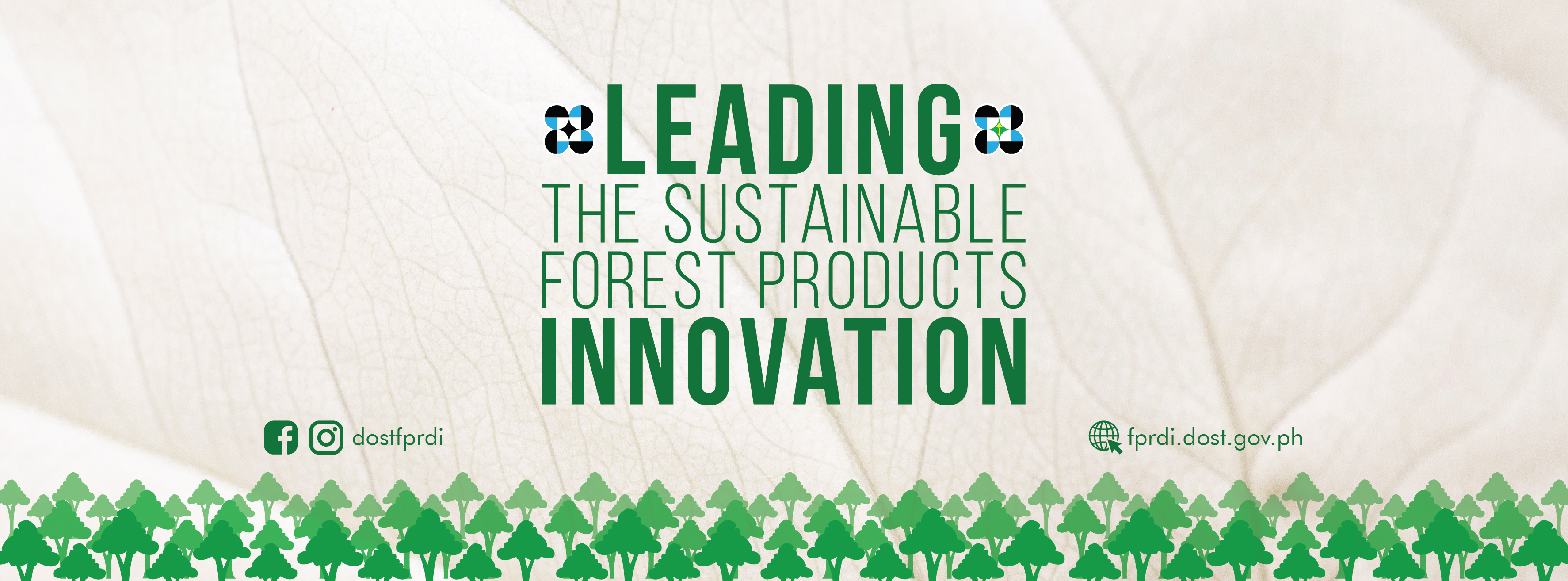Plywood
- Details
Plywood Tests
Evaluate surface appearance of plywood or “the nature and limits of characteristics inherent in wood and manufacturing defects enabling the visual assessment of the plywood for allocation to an appearance class” as specified in PNS/ISO 2426-2:2021
Measure the thickness, determine moisture content and density of Class III ((High Humidity/Exterior Conditions) or Type I (Exterior/Marine); Class I (Dry conditions) or Type II (Interior/Ordinary) plywood and blockboard; and Class II (Tropical dry and Humid conditions) or substandard Type I.
Evaluate bond quality thru wet shear test and percent wood failure for Classes I to III and Type I plywood. Determine bending strength of Classes I to III and conduct 3-cycle delamination for Type II plywood and blockboard.
Performed using several equipment such as the digital micrometer for thickness; laboratory oven and digital weighing balance for moisture content; boiling vat, laboratory oven, plywood testing machine (shear and bending), and magnifying lens for the bond test of Classes I-III and Type I plywood; three-cycle delamination oven and dipping vat for the bond test of Type II plywood.
Based on PNS/ISO 12465:2017 as required by the DTI-Bureau of Product Standards.
PNS/ISO 1954, Plywood – Tolerances on dimensions
PNS/ISO 2426-2, Plywood – Classification by surface appearance – Part 2: Hardwood
PNS/ISO 2426-3, Plywood – Classification by surface appearance – Part 3: Softwood
PNS/ISO 9426, Wood-based panels – Determination of dimensions of panels
PNS/ISO 9427, Wood-based panels – Determination of density
PNS/ISO 12466-1, Plywood – Bonding quality – Part I: Test methods
PNS/ISO 12466-2, Plywood – Bonding quality – Part 2: Requirements
PNS/ISO 16978, Wood-based panels – Determination of modulus of elasticity in bending and of bending strength
PNS/ISO 16979, Wood-based panels – Determination of moisture content
We can also accommodate plywood testing using other standards like PNS 196:2000, EN 636 (European Plywood) and PS 1-19 (American Plywood).
FPRDI’s Plywood Testing Laboratory has been accredited according to PNS ISO/IEC 17025:2017 or the General Requirements for the Competence of Testing and Calibration Laboratories as per DTI-PAB Accreditation Number: LA-2022-411A, valid up to November 23, 2027. Further the Laboratory has been recognized by DTI-BPS, as per Recognition No: TL-0006 valid up to February 19, 2026
Adhesives, Sealants and Coatings
Adhesive Tests
- Analyze the properties of adhesives such as viscosity, total solids, pH, flammability and volatile matter.
- Characterize the main components of adhesives using Fourier Transform Infra-red (FTIR).
- Analyze thermal properties of adhesives using Differential Scanning Calorimetry (DSC) and Thermogravimetric Analysis (TGA).
- Also determine the formaldehyde emission of wood and related products. Exporters of wood furniture and furnishings must abide by the importing countries’ strict policy regarding the F-emission limits on wood and similar products.
Pulp & Paper
- Details
PULP, PAPER & PAPER BOARD TESTING
Paper and Paper Board Tests
- Analyze paper and paper board physical and optical properties such as texture, grammage, brightness, thickness and density.
- Examine the proximate chemical analysis for moisture, ash, extractives which include alcohol-cyclohexane, 1% NaOH, and hot/cold water and klason lignin.
- Determine strength properties such as resistance to bending, puncture, tearing, and crushing force of paper and board.
- Based on the following standards:
- ISO 2470 (Measurement of diffuse blue reflectance factor)
- ISO 2471 (Determination of opacity)
- ISO 1974 (Determination of tearing resistance)
- ISO 536 (Determination of grammage)
- ISO 534 (Determination of thickness, density and specific volume)
- ISO 1924 (Determination of tensile properties)
- ISO 2758 (Paper -- Determination of bursting strength)
- ISO 2759 (Board -- Determination of bursting strength)
- ISO 3035 (Determination of flat crush resistance)
- ISO 7263 (Determination of the flat crush resistance after laboratory fluting)
- ISO 13821 (Determination of edgewise crush resistance)
- ISO 5626 (Paper -- Determination of folding endurance)
- ISO 5627 (Determination of smoothness)
- TAPPI 462 (Castor Oil Penetration Test for Paper)
- TAPPI 437 om-08 (Dirt in Paper and Paperboard Test Method)
- ISO 535 (Determination of water absorptiveness)
- ISO 2493 (Determination of resistance to bending)
- ISO 3037 (Determination of edgewise crush resistance (unwaxed edge method)
- ISO 2471 (Determination of opacity)
- ISO 1974 (Determination of tearing resistance)
- ISO 536 (Determination of grammage)
Pulp Tests
- Evaluate the different pulp properties such as yield, Kappa number, Klason lignin, alcohol-cyclohexane solubility, hot/cold solubility, caustic soda solubility and beating properties of raw materials for making pulp.
- Based on the following standards:
- T 236 om-06 (Kappa Number of Pulp)
- T 222 om-06 (Acid-insoluble Lignin in Wood and Pulp)
- T 204 cm-07 (Solvent Extractives of Wood and Pulp)
- T 207 om-08 (Water Solubility of Wood and Pulp)
- T 213 om-06 (Dirt in Pulp)
- TAPPI T 411 [Thickness (Caliper) on Paper and Paperboard]
- TAPPI T 425 [Opacity of Paper (15°/Diffuse, Illuminant A) 89% Reflectance Backing and Paper Backing]
- TAPPI T 494 (Tensile Breaking Properties of Paper and Paperboard Using Constant Rate of Elongation Apparatus)
- TAPPI T 403 (Bursting Strength of Paper)
- TAPPI T 414 (Internal Tearing Resistance of Paper)
- TAPPI T 515 [Folding Endurance of Paper (MIT Tester)]
- TAPPI T 550 (Determination of Equilibrium Moisture in Pulp, Paper, and Paperboard for Chemical Analysis)
Furniture Tests
- Details
Furniture Tests
Evaluate the strength, durability and stability of chairs, stools, desks/tables, beds, monobloc chairs and stools and plastic tables, and storage furniture by applying loads and simulating the normal functional use and acceptable misuse following test standards.

Based on the following test standards:
- PNS 1478: 1998 (Monobloc chair, monobloc stool and plastic table)
- BS EN 1730: 2000 (Domestic furniture. Tables. Test methods for determination of strength, durability and stability)
- BS 4875-5:2001 (Strength and stability of furniture. Requirements for strength, durability and stability of tables and trolleys for domestic and contract use)
- ANSI/BIFMA X5.5-2008 (American National Standard for Office Furnishings-Desk Product)
- BS EN 1728: 2001 (Domestic furniture. Seating. Test methods for the determination of strength and durability)
- BS 4875-1:2007 (Strength and stability of furniture. Requirements for the strength and durability of the structure of domestic seating)
- BS EN 15373:2007 (Furniture. Strength, durability and safety. Requirements for non-domestic seating)
- BS EN 1729-1:2006 (Furniture. Chairs and tables for educational institutions. Functional dimensions)
- BS 4875-3:1985 (Strength and stability of furniture. Methods for determination of strength of settees)
- ISO 7173:1989 (Furniture -- Chairs and stools -- Determination of strength and durability)
- ISO 7174-1:1988 (Furniture – Chairs Determination of stability -- Part 1: Upright chairs and stools)
- ISO 7174-2:1992 (Furniture -- Chairs Determination of stability -- Part 2: Chairs with tilting or reclining mechanisms when fully reclined, and rocking chairs)
- BS 4875-4:1985 (Strength and stability of furniture. Methods for determination of stability of settees)
- BS EN 1022:1997 (Domestic furniture. Seating. Determination of stability)
- ANSI/BIFMA X5.1-2002 (American National Standard for Office Furnishings – General Purpose Office Chairs - Tests).









